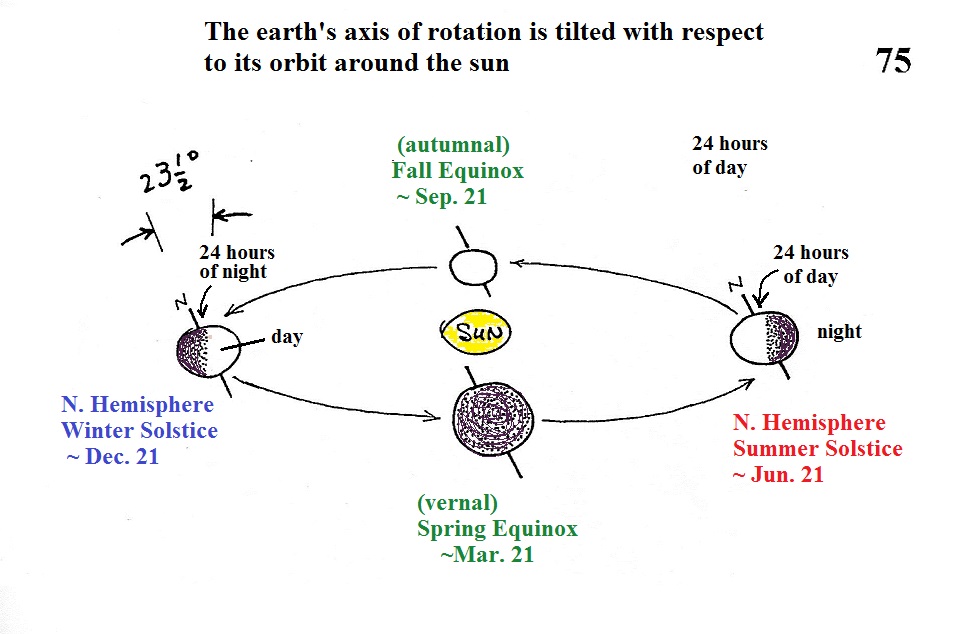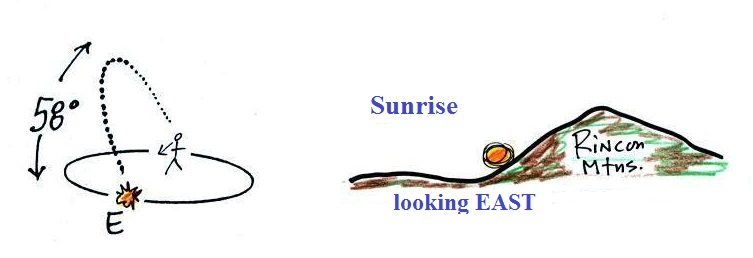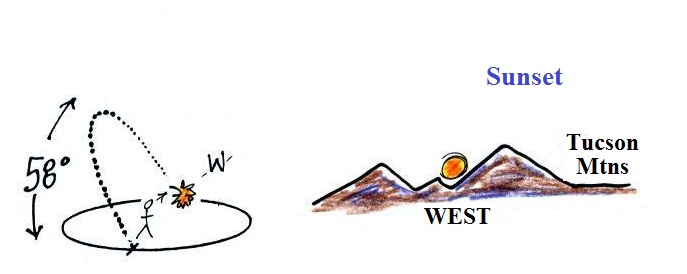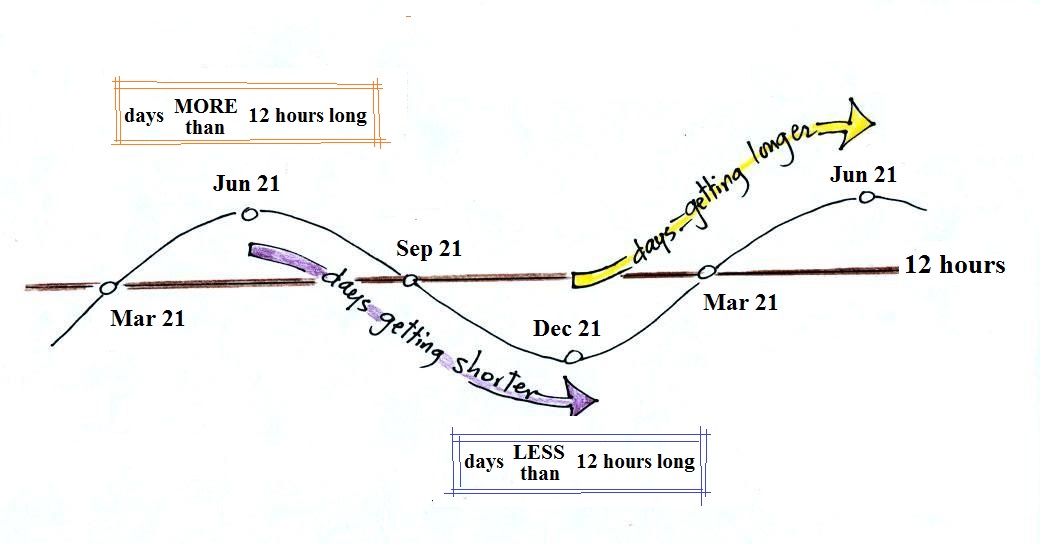The Equinoxes
The Spring Equinox this year is Wednesday,
March 20 this year (2:58 pm MST in Tucson). You
can get killed on or near the equinoxes if you're not careful
(more about that later). So I want you to be ready for it.

The figure above shows the
earth orbiting the sun. The earth is tilted slightly
with respect to its orbit around the sun.
On or around Dec. 21st, the winter solstice, the north
pole is tilted away from the sun. Note that a small
portion of the earth near the N. Pole (north of the Arctic
Circle) is in darkness for the entire day. Elsewhere
in the northern hemisphere days are less than 12 hours
long and the sun is low in the sky. Both factors
reduce the amount of sunlight energy reaching the
ground. That's why it's cold and wintry.
On June 21st, the summer solstice, the north pole is
tilted toward the sun. Now there are 24 hours of
sunlight north of the Arctic Circle. Days are more
than 12 hours long in the northern hemisphere and the sun
is high in the sky at noon. A lot more sunlight
energy reaches the ground; that's why it is summer.
The equinoxes are a time of transition. On the
equinoxes, the N. Pole still tilted just not toward or
away from the sun. The line separating day and night
passes through the pole and the days and nights are each
about 12 hours long everywhere on earth (except perhaps at
the poles where the sun stays right at the horizon all day
long).
The drawing below shows you what you would see at sunrise
(about 6:30 am) on the Fall Equinox here in Tucson (the same
would happen on the Spring Equinox).
The sun
rises exactly in the east on the equinoxes. The rest of
the year it is a little to the north or south of east.

At noon you would need to look due south to see the sun.
The sun reaches its highest point in the sky at noon.
On the equinoxes in Tucson that's almost 60 degrees.
The sun is lower in the sky (34.5 degrees above the horizon)
on the winter solstice. That together with the fact
that the days are shorter means much less sunlight energy
reaches the ground. In the summer the days are longer
and the sun gets much higher in the sky at
noon (81.5 degrees above the horizon, nearly
overhead). Much more sunlight energy reaches the
ground and it is much warmer.
The sun passes directly overhead at the equator at noon on
the equinoxes.

The sun sets
exactly in the west on the equinoxes at about 6:30 pm in
Tucson.
Because you're in the 8am
section of ATMO 170 this semester you might be out of bed in
time to see the sunrise. Most everyone is likely to see
the sun set. The figure below shows you about what you
would see if you looked west on Speedway (from Treat Ave.) at
sunset. In the winter the sun will set south of west, in
the summer north of west (probably further south and north
than shown here). On the equinoxes the sun sets exactly
in the west. This is something you should check out for
yourself this week before the sun moves noticeably to the
north of due west.

Something else to note in this figure.
Note how the sun is changing color. It changes
from a bright yellow white to almost red by the time it
sets.. This is due to scattering of sunlight by
air. The shorter wavelengths (violet, blue, green) are
scattered more readily than the longer wavelengths. At
sunset the rays of sunlight take a much longer slanted path
through the atmosphere and most of the shorter wavelengths are
scattered and removed from the beam of sunlight. All
that's left in the beam of light that reaches your eyes are
the longer wavelengths: yellow, orange, and red.
You
might have noticed that the sketch seems to be
pretty carefully drawn. That's because
several years ago I positioned myself in the
median near the intersection of Treat and Speedway
and pointed my camera west. I took a
multiple exposure photograph of the sun over a 2
or 3 hour period that ended at sunset.
Here's the photo I ended up with (it's a copy of a
copy so that picture quality isn't all that
great):
If you
aren't careful, you can get yourself seriously injured, even
killed, on or around the equinoxes. Here's
an article that warns of the danger (it appeared in the
Arizona Daily Star at the time of the 2011 Fall
equinox).
June 21, the summer
solstice, is the longest day of the year (about 14 hours of
daylight in Tucson). The days have slowly been getting
shorter since then. The rate of change is greatest at the
time of the equinox.
The days will continue to get shorter up until December 21,
the winter solstice, when there will be about 10 hours of
daylight. After that the days will start to lengthen
again as we make our way back to the summer solstice.
There was a very interesting coincidence a few years ago.
We were covering some of this same material in class on a
Friday afternoon. There were a few parents in class because
it was Parent's Weekend. I showed these same pictures on
that afternoon. One of the parents came up to the front
after class and mentioned having seeing the sun right at the end
of 77th St. in New York City around this time of year. That
got me thinking that a picture of sunset at the end of one of the
long streets with all the tall buildings might be spectacular.
When I started looking however I found that the major streets in
Manhattan aren't oriented EW and NS. You can see this on a Google
map of Manhattan. 77th St. is oriented in more of a
NW-SE direction. So the sun doesn't shine straight
down 77th St. at sunrise and sunset on the equinoxes. I was
pretty disappointed but then I stumbled on the this Manhattanhenge
map which shows the direction
of sunset (the left, west, side of the map) and sunrise (the
right, east, side of the map) at various times of the year.
The "henge" part of the name comes from Stonehenge
where the rising and setting sun aligns with stones on the
solstices.
The sun rises in the east and sets in the
west on the equinoxes. As you move past the Spring Equinox
toward summer sunrise moves north of east and sunset is north of
west. On May 31 the sun has moved far enough north that it
does set right at the west end of 77th St. Sunset
continues to move north up until the summer solstice on June
21. Then the sunset starts to move back south. You
can again see the sunset at the west end of 77th St. on July 12
and 13. Here's a gallery
of Manhattanhenge images.
Manhattanhenge is a little confusing and hard to figure
out. But do look at the photographs with the idea that you
can see something similar here in Tucson on the equinoxes (minus
all the tall buildings).
You can also see the sunrise at the east end of 77th St.
But sunrise has to be in the southeast. This takes place on
Dec. 5 and Jan. 8, just before and just after the winter solstice.






